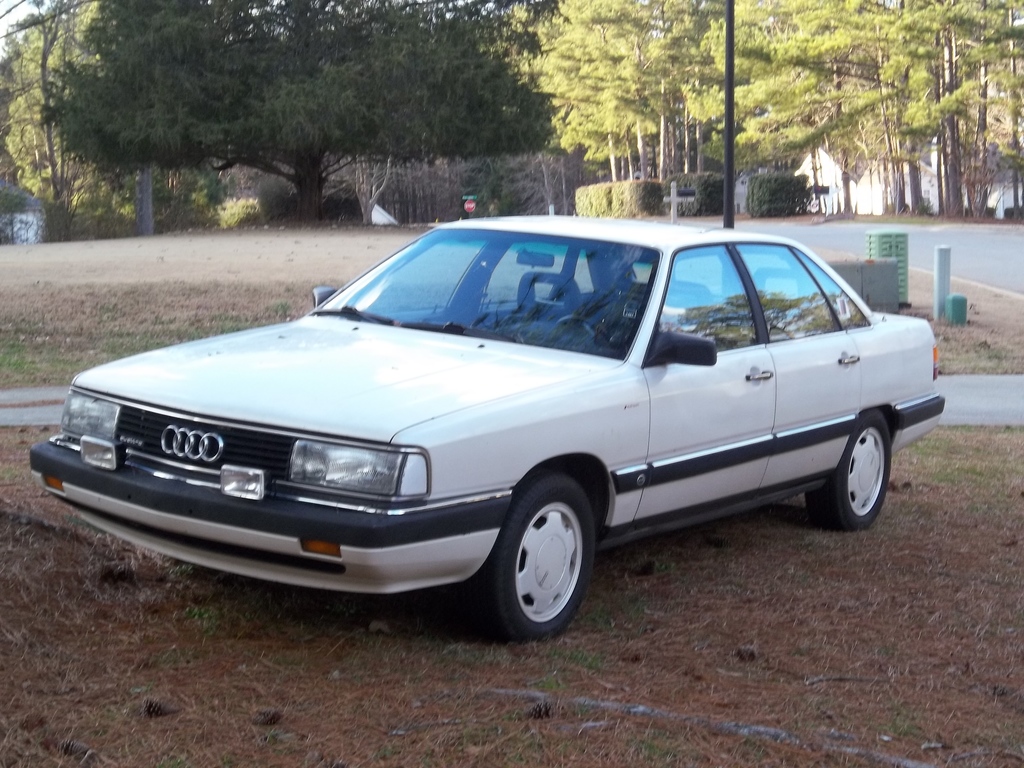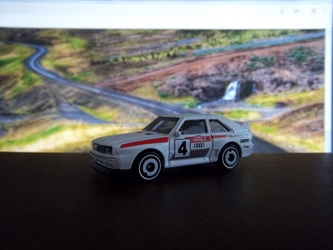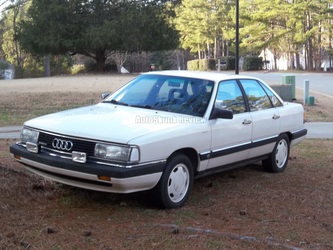Sign In
CloseThe Audi Quattro story part 2 (AutoSkunk review) by ShawnSkunk
If you guys thought the UrQuattro was pretty badass then wait until you
read part two of the Audi Quattro story.
this time Audi leaves the dirty, dusty, bumpy, and muddy dirt and gravel
snow covered roads of the rally circuit and goes racing on the on the
twisty road courses and tight street circuits of the SCCA and IMSA Trans
Am series, and the DTM series with three cars, the first two that
practically became legendary with their 5 cylinder engines the Audi 200
Quattro (also called the 5000 CS Quattro in North America) and Audi 90
Quattro, these two saloon cars would bring Audi even more fame from 1988
to 1989, afterwards the SCCA banned all wheel drive race cars from
competing in Trans Am after the cars enjoyed what the SCCA believed was
too much of an unfair advantage, and the Audi RS6 a car which Hans Stuck
won 7 races with in the DTM series, but as for the 200 and 90 Quattros
they did do what Audi set out to do, they help Audi generate much needed
sales during a time when sales in North America were plummetting and the
company needed a desperate boost to stay in the market.
so enough spoilers, this is part 2 of the Audi Quattro story:
By 1987 Audi was still competing in the WRC series but the UrQuattro was
longer competing, it was pulled from rallying after the FIA pulled the
plug on it's Group B program, instead Audi replaced the UrQuattro with
the 200 saloon as their next rally car and assigned it to compete in the
Group A rally class driven by WRC champions Hannu Mikola and Walter
Rohrl and they rallied it with some success, with it's turbocharged 2.2
liter 20 valve 5 cylinder engine Hannu Mikola drove the 200 Quattro to
victory in the 1986 Safari Rally making the Audi 200 Quattro the first
all wheel drive rally car to win the Safari Rally.
the 200 was the last car Audi would ever rally as a manufacturing team,
in North America Audi was losing sales on it's passenger cars especially
sales on the 200 when a string accidents some of them deadly occurred
across the United States involving their flagship 200 (or 5000 as it was
called in the United States) horrified buyers due to a problem of
unintended acceleration when the car had sudden surge of power and
accelerated uncontrollably when the driver tried to stop the car.
after an investigation by the NHTSA (National Highway Transportation
Safety Administration) it was revealed that there was a problem with
driver's being confused by the car's pedal design and a problem with the
idle stabilizer system when it produces an initial acceleration of 0.3g
causing the driver hit the wrong pedal out of either panic, confusion,
or unfamiliarity with the car's design, it was also confirmed to be
caused by multiple intermittent malfuntions with the electronic throttle
control which was discovered and reported by Transport Canada.
even though Audi corrected these problems they still felt the sting when
their sales continued to fall, not even their rally efforts could help
generate sales as rallying wasn't much of a popular sport in America
(stupid Americans, we're always soo spoiled by our Nascar and love of
oval tracks and drag racing), so in response to this concern Audi pulled
out of the WRC series and decided to take another direction in their
racing efforts.
in 1986 as a publicity stunt Audi decided to do a speed record attempt
at the Talledega Superspeedway, they took their 200 sedan and gave it
some Nascar spec like modifications, they lightened the body with kevlar
bumpers, aluminum doors, and plastic windows.
aerodynamics were improved with spoilers front and rear (the rear one
being smaller for balance of downforce on the high banked turns of 2.2g
and drag co-efficient of 0.33), the car was made entirely asymmetric to
handle the large lateral load of 1.6g in the steep 30 plus degree
banking of superspeedways, asymetric suspension (stiffer on the right
side), asymetric drivetrain, a moving engine, gearbox, driveshaft, and
differentials that were off center by 5cm to the left side, fuel tank,
oil reservoier, and even the battery was moved to the left side, by the
time they finished the modifications the final left-right weight
distribution was an almost even 53:47.
Audi stuck with the turbocharged 2.1 liter inline 5 outfitted with an
intercooler and modified it with a 25 valve head, titanium rods
resulting in 650 horsepower.
Michelin provided special tires for the run wich were tested for speeds
up to 279 miles per hour and Audi of course never forgetting that
trademark Quattro all wheel drive system was part of the car too.
as a final touch Audi renamed the car with it's North American name
"5000 CS Quattro" to promote the American variant.
driving it would be Indy 500 champion Bobby Unser (then retired at the
time), inspite of the cars boxy design he hit a speed of 206.825MPH and
set a world record for all wheel drive cars and reached a top speed of
217MPH setting 10 new international speed records.
confident that they can be competitive on pavement, Audi set their
sights on the SCCA Trans Am circuit, by 1988 they were ready with an
SCCA competition prepped 2.1 liter 510 horsepower 200 Quattro and
drivers Hans Joachim Stuck, Hurley Haywood, and Walter Rohrl.
their first stop? California, on the streets of Long Beach, domestic
teams from Ford, Gm, and Chrsyler flocked to look at the dazzling new
race car Audi was going to be racing, it was nothing like any of the
other contendors on the track.
Hans Stuck took his first ride in an all wheel drive Trans Am race car
in a qualifying round, the 200 Quattro was no match for the more
powerful V8 American cars like the Camaro but the car does have an
advantage in the tight corners of the Long Beach street circuit, he
qualified 4th.
in the race, Hurley Haywood another Audi driver suprises everybody when
he finishes in second place on his first run, experts who witnissed his
finish regarded it as beginner's luck, Haywood eventually wins Audi
their first Trans Am victory in the next race on the Dallas street
circuit, winning it easily as the 200 held a firm grip on the track
thanks to it's Quattro all wheel drive while the other cars (all of them
rear wheel drive) were slipping and sliding around as track conditions
deteriorated as the race went on, it was also the first Trans Am victory
for an all wheel drive race car, he wins again in the next race on the
streets of Detroit Michigan after taking the lead on the last lap
recording a second victory for himself and Audi.
Audi's next race was at Niagra Falls and this time Walter Rohrl would
win giving the team and the company their third consecutive victory
bringing the score up to winning three of the first five races in the
1988 season, meanwhile the fastest man in a rear wheel drive race car
Hans Stuck was struggling with driving the 200 Quattro, his problem was
with trying to keep the turbo boost pressure up, too much lagging was
making his acceleration sluggish and thus was struggling to finish high
in a race or even win.
soon he eventually figured out how to drive an all wheel drive race car
and on went on a winning streak with the 200 Quattro, he wins in
Cleveland, and then in Brainerd, and again at a race in the Netherlands,
he quickly found that the left foot braking technique would help him
keep the throttle open a little and keep the boost pressure up and
therefore preventing turbo lag from occurring.
the next race in the 1988 season was at the Mid Ohio Sports car course,
it was a wet and rainy day with a heavy downpour and the track was
soaked, the audi team sang their praises for the rain for they knew that
the rain would be on their side and give them the advantage they need to
succeed, the 200 Quattro's run away from the pack while the rear wheel
drive race cars struggled to stay on the track, Stuck and his teamates
at that point were pretty much enjoying a Sunday drive, their Quattro
all wheel drive system kept the 200 on the track like glue.
but by then the others drivers, teams and even the SCCA officials
themselves were beginning to think that the Audis were enjoying too much
of an unfair advantage, they were accusing the team of sand bagging
meaning holding back their power during practice and then unleashing it
late in the race, blame aside the other racing teams were lobbying for a
rule change to try to level the playingfield, eventually the SCCA
officials agree and try their best to handicap the 200 Quattros by
adding a couple hundred pounds of aditional weight on the cars, thinner
tires, and a reduced turbo inlet with less boost but the Audi team
wasn't phased by these changes.
inspite of the handicaps, the 200 Quattros still prevailed and by the
end of the 1988 season they won Audi the manufacturer's championship and
Hans Stuck took 4 wins that year and Hurley Haywood takes home the
driver's championship, afterwards Audi wasn't invited back to compete
again the following year so Audi decides in 1989 they would climb the
latter to a higher up Trans Am series, the IMSA series and after all as
one would say "success demands promotion".
Audi had a new car ready for the IMSA series, the Audi 90 Quattro IMSA
GTO, this was an exotic tube frame race car that was faster and more
powerful than the 200 Quattro.
it used the same 5 cylinder turbo engine from the 200 but was given more
power, horsepower was increased from 510 to 720 a tremendous boost in
power,the engine was fitted with a 2.65 bar turbo and intercooler.
the 90 Quatro GTO also used a space age telemtry system mounted on it's
wheels, this monitor's the cars performance every second and helps
provide the team with data to use to improve their cars, it was a high
tech master piece.
unlike in the SCCA series the IMSA series allowed Audi to drive without
any handicaps and all IMSA race teams are allowed to drive with wider
tires, IMSA officials were confident that the all wheel drive Audis
wouldn't enjoy an unfair advantage in their ring and at the time in 1989
Audi's toughest competitor's were the Mercury Cougar XR7's of Roush
Fenway Racing and the Nissan 300 ZX's of Cunningham Racing which won 7
out of 15 races in 1989.
two Audi 90 Quattro GTO's make their debut on a closed street course in
Miami in 1989 with Hurley Haywood and Hans Stuck at the wheel, inspite
the strong competition from Roush and Cunningham the 90 Quattros gain
the upper hand in the race impressing almost everyone including an ESPN
commentator named Bill Adam but inspite their superior edge the 90
Quattro's had gearbox trouble and both were out of the race, the cause
of it was the cars had too much horsepower for the gearboxes and
driveshafts, they broke under the tremendous strain.
the Audi team worked hard to improve the cars to help them go the
distance, Summit Point would prove to be their day of triumph, the 90
Quattros not only go the distance but they win the race finishing in 1st
and 2nd with Hans Stuck taking the win an amazing comeback, afterwards
they win again at Mid Ohio, and later Hans Stuck would take home a
string of victories from Topeka, Sears Point, Watkins Glen, Lime Rock,
and Laguna Seca.
a neat little quirk about the Audi 90 Quattro GTO is how it can pop a
wheelie when coming off a hump on a racetrack in fact there are photos
of that moment you can look up online and see for yourself, it's really
cool to see but yet more cool to watch on youtube (look up "secrets of
speed:unfair advantage on youtube if you want to see the 90 Quattro pop
a wheelie, you will be amazed ;3).
after the 1989 IMSA season because of the tough comepition mostly from
the Cunningham Nissan's Audi this time around didn't win the
manufacturer's title or the driver's title but in the end both the 200
Quattro in SCCA Trans Am and the 90 Quattro in IMSA did what Audi sent
them out to do, sales in North America on their passenger cars picked up
but they would never reach the numbers Audi once had in the beginning
until model year 2000, and after the 1989 season drew to a close Audi
stop competing in the IMSA series and withdrew, after IMSA Audi focused
their attention to their native homeland Germany on a domestic racing
series, the Deutsche Tourenwagen Masters.
in 1990 because the DTM rules banned turbocharged engines starting that
year Audi could no longer use the legendary turbocharged 2.1 or 2.2
liter inline 5 cylinder engines which also meant neither the 200 or 90
Quattros could comepete so Audi instead turn to their top range model,
the Audi RS6 Quattro, this like it's name suggest sports the Quattro all
wheel drive system but instead of a 5 cylinder engine the RS6 Quattro
had an all aluminum 3.6 liter naturally aspirated V8, while the factory
version of this engine had 250 horsepower for the street Audi gave it a
few minor tweeks raising it's power up to 420 horsepower at the start
season, that power by the end of the 1990 season would be raised to 460
and would be coupled to a six speed gearbox, the car when modified for
DTM competition was nothing more than a gutted shell of a road car
outfitted with a roll cage.
the RS6 Quattro made it's debute with Hans Stuck, Walter Rohrl, and
Frank Jelinski at the wheel, Stuck right away drove the car to a podium
finish in it's first race,on the fourth round at the Avus Circuit, Hans
Stuck won both races, he would go on to win 5 more races afterwards with
the RS6 Quattro which was enough to give him the driver's championship
ahead of BMW driver Johnny Cecotto at Hockenheim.
through the winter of 1990, changes were made to the RS6 Quattro, some
of those changes included a front and rear spoilers.
eventually another driver joined the Audi team Frank Beila, he joined as
one of Stuck's full time drivers along with Hubert Hobt, Stuck and Beila
would dominate the upcoming season with Frank Beila this time around
taking the 1991 DTM championship in the final race once again at
Hockenheim.
after a 1992 season the DTM would ban Audi's V8 Quattro (Audi just can't
seem to catch a break can they?) and so Audi once again shift their
focus on another race series, the french super touring car championship
but there's really not much I could tell you about that because I
couldn't find much information on their involvement in that series and
believe me I looked high and low on the internet and only found so
little info I could find, all that I found is Audi competed in the
French series in 1993 with an Audi 80 Quattro touring car powered by a
2.5 liter engine possibly the 5 cylinder engine driven by Frank Beila
and and local French driver Marc Sourd and they won the 1993 French
Supertouring championship with Frank Beila claiming the driver's title.
and that was part 2 of the Audi Quattro history review, so far I've only
talked about the Quattro system's racing exploits and the race cars that
made it and the brand famous in the 80's and 90's, part 3 will be the
final page of this review only this time I'll be focusing on the
evolution of the Quattro all wheel drive system and it's technological
innovations it received over the years all the way to present day and
the cars that first received the new innovations all from past to
present, I hope you all enjoyed this part of the review and have been
enjoying this review so far and if you like what you read then please
feel free to follow me on Furaffinity, Twitter, and Weasyl for more car
and automobile history reviews, until then I'll see you guys next time
for the final part of this review on the next AutoSkunk review. :3
(photo for this review was by me and yes folks this is actually my car, a 1987 Audi 5000 CS Quattro with a 2.2 liter tubocharged inline 5 cylinder engine, the stuff of legend, and believe guys this was a once in a lifetime find you rarely find a car like this for sale by owner anywhere in North America especially once in good running condition with a performance chip in it for $1,400 dollars and no I haven't driven it yet, it currently doesn't run right now, it needs repairs done, it's soo depressing not being able to drive it yet QnQ)
Submission Information
- Views:
- 482
- Comments:
- 0
- Favorites:
- 0
- Rating:
- General
- Category:
- Visual / Photography




